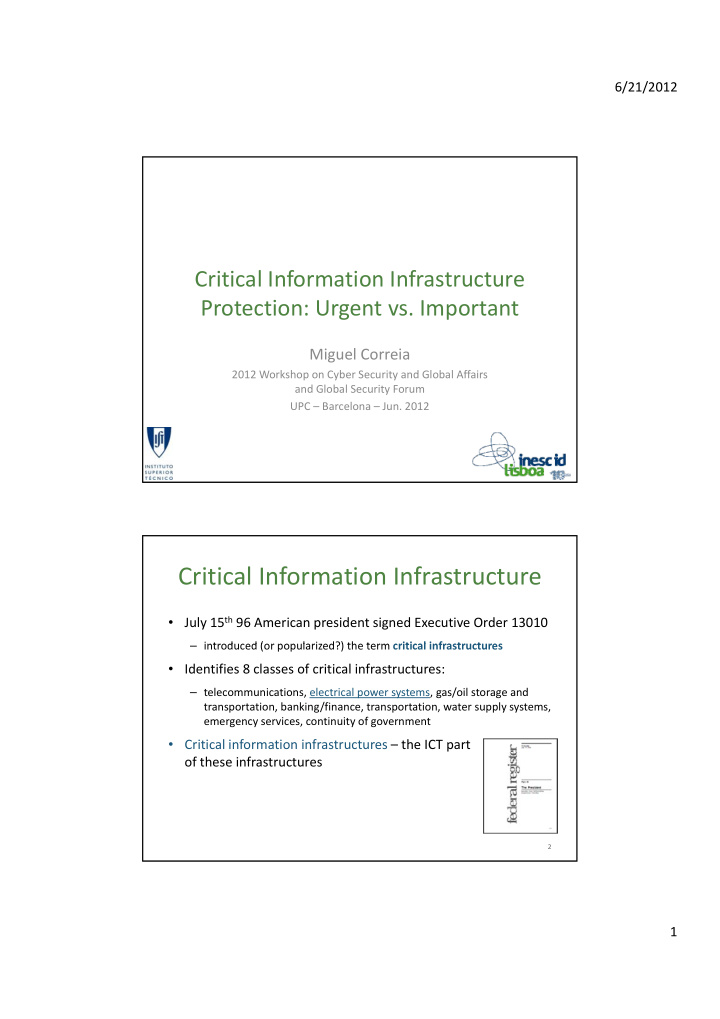



6/21/2012 Critical Information Infrastructure Protection: Urgent vs. Important Miguel Correia 2012 Workshop on Cyber Security and Global Affairs 2012 Workshop on Cyber Security and Global Affairs and Global Security Forum UPC – Barcelona – Jun. 2012 Critical Information Infrastructure • July 15 th 96 American president signed Executive Order 13010 – introduced (or popularized?) the term critical infrastructures introduced (or popularized?) the term critical infrastructures • Identifies 8 classes of critical infrastructures: – telecommunications, electrical power systems, gas/oil storage and transportation, banking/finance, transportation, water supply systems, emergency services, continuity of government • Critical information infrastructures – the ICT part of these infrastructures 2 1
6/21/2012 Power grid • Recent past: – Power grid undergone significant computerization and interconnection P id d i ifi t t i ti d i t ti – Improved operation, but became exposed to cyber ‐ threats • Present/future: – Smart grid: smart metering, distributed generation… ‐ ICT is core – More computerization and interconnection, higher exposure to cyber ‐ threats threats 3 Power grid is under siege • 2003: Davis ‐ Besse nuclear power plant’s control systems blocked by the Slammer/Sapphire worm blocked by the Slammer/Sapphire worm • 2007: experimental DHS ‐ sponsored cyber ‐ attack destructs a power generator • 2009: US electrical grid allegedly penetrated by spies from China, Russia and others • 2010: Stuxnet damages centrifuges in Iranian nuclear 2010: Stuxnet damages centrifuges in Iranian nuclear enrichment center 4 2
6/21/2012 URGENT: REDUCING RISK 5 Risk is high risk = level of threat X degree of vulnerability X impact likelihood of successful attack • Level of threat is high – nation states, random threats, extortion • Degree of vulnerability is high – as shown by the previous cases • Impact is high – think of a city without power for hours/weeks It is urgent to reduce this risk By reducing the degree of vulnerability 6 3
6/21/2012 NIST SP 800 ‐ 82 • “Guide to Industrial Control Systems (ICS) Security”, Jun. 2011 • Recommendations about • Recommendations about – Network architecture – firewall usage, network segregation,… – Management controls – planning, risk assessment,… – Operational controls – personnel security, contingency planning, configuration management,… – Technical controls – authentication, access control, systems and communication protection,… • ICT security applied to CIIP 7 IEC 62351 • “Power systems management and associated information exchange – Data and communications security”, May 2007 exchange Data and communications security , May 2007 • Recommendations about the security of TC57 protocols – protection from eavesdropping, man ‐ in ‐ the ‐ middle, spoofing, and replay • ICT security applied to CIIP 8 4
6/21/2012 Urgent to apply these standards • In comparison with “normal” ICT systems… • before applying these standards: • before applying these standards: risk = level of threat X degree of vulnerability X impact much much higher! higher! higher! higher! 9 Urgent to apply these standards • In comparison with “normal” ICT systems… • after applying these standards: • after applying these standards: risk = level of threat X degree of vulnerability X impact much much higher! same higher! higher! The risk must still be more reduced! The degree of vulnerability has to become much lower than in ICT systems 10 5
6/21/2012 IMPORTANT: RESEARCH ABOUT REDUCING RISK MUCH MORE 11 Architecture – WAN ‐ of ‐ LANs Substation A Substation B Substation C 12 6
6/21/2012 CIS ‐ CRUTIAL Information Switch Substation A Substation B Substation C 13 CIS Protection Service • Objective: effectively block incoming attacks • CIS PS works at application layer and is a distributed firewall • CIS ‐ PS works at application layer and is a distributed firewall • It is intrusion ‐ tolerant thanks to replication and diversity • It is self ‐ healing thanks to replica rejuvenation • It cannot be attacked even if there are 0 ‐ day vulnerabilities 14 7
6/21/2012 CIS Communication Service • Objective: circumvent faults and DDoS attacks in the WAN • CIS run JITER algorithm – timely ‐ critical messages exploit: • CIS run JITER algorithm – timely ‐ critical messages exploit: • Multihoming: CII facilities often connected to 2 ISPs • Overlay channels: messages sent indirectly through other CIS • Communication is timely/secure even under harsh fault/attack scenarios Network fault, CIS C CIS C DD S tt DDoS attack k CIS A CIS B CIS D 15 New directions beyond CRUTIAL • Threats like Stuxnet might not be blocked by these mechanisms; some research directions: mechanisms; some research directions: • Replication/rejuvenation/diversity inside the LANs – For critical servers, e.g., SCADA servers – For control devices: Programmable Logic Controllers (PLC), Remote Terminal Units (RTU) • Continuous vulnerability assessment (instead of periodic scanning) scanning) • Anomaly ‐ based endpoint assessment 16 8
6/21/2012 Conclusions • The power grid and other critical information infrastructures are vulnerable to cyber ‐ attacks are vulnerable to cyber attacks • It is urgent to do the urgent: apply standards and recommendations • But ICT ‐ like security mechanisms are not enough: the threat level and impact of CII failure is high, so risk remains high • So it is important to do what is important: to investigate novel So it is important to do what is important: to investigate novel protection mechanisms that greatly reduce the degree of vulnerability 17 More info at my web page: google miguel correia inesc id More info at my web page: google miguel correia inesc ‐ id 9
Recommend
More recommend